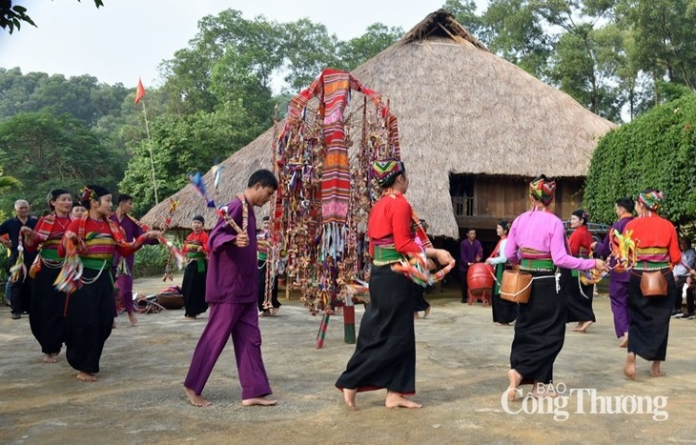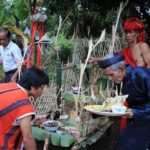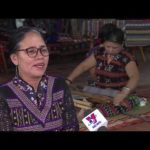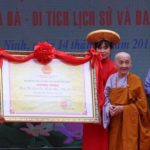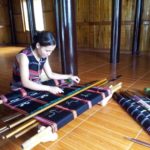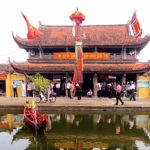The Poon Poong Festival, a vibrant celebration steeped in folk beliefs, holds significant cultural importance for the Muong community.
According to local Muong, Bui Hong Nhi, the term ‘Poon’ in their language signifies playing or dancing, while “Poong” refers to flowers. Thus, “Poon Poong” beautifully translates to dancing around the flower tree.
“Au May,’ a respected and knowledgeable female villager, leads this festival,” Nhi explained. “She is well-versed in traditional worship, medicine, and the arts of dancing and singing.”
Poon Poong is a two-part celebration, comprising a ritual and a festival. During the ritual, the Au May, assuming the role of a shaman, narrates the creation story of heaven and earth. She offers gratitude to the Genies for the abundant harvest and favorable weather. This solemn ceremony is followed by joyous festivities, where villagers come together to sing and dance.
In addition to the Au May, the festival requires at least six other performers to sing and dance around the flower tree, the centerpiece of the celebration. For the Muong people, this handcrafted tree symbolizes the vast universe and embodies the fusion of nature’s gifts to humanity.
Creating the flower tree is an act of gratitude and an invitation to the Genies to join in the merriment with the locals. Adorned with colorful flower clusters and animal or tool shapes, the tree stands tall with 5 or 7 tiers, crafted from dyed cypress wood. The number of tiers reflects the skill and status of the Au May ladies, influencing the tree’s height.
Bui Van Dong, a local from Ngoc Lac district in Thanh Hoa province, shared that the flower tree is decorated with painted wooden animals and flowers, along with vibrant fabrics. Its creation demands the skills of artisans and requires significant time and meticulous attention to detail.
Pham Thi Bao, also from Ngoc Lac district, noted that while the Poon Poong festival traditionally takes place in the first lunar month, it is now also celebrated on other special occasions. “On the 7th day of the lunar year, a flower tree graces either the commune center or the temple gate, becoming a focal point for dance and song,” she said, adding that the Au May leads the worship and prayer while others immerse themselves in the festive atmosphere through dance, song, and the rhythmic beating of gongs.
According to Bui Van Dong, the Poon Poong Festival has endured throughout history, preserving the cultural traditions of the past. Each village and commune hosts this festival, celebrating it on different days during the first lunar month. The performances revolve around the flower tree, reflecting the customs and traditions unique to the Muong people and offering a glimpse into their cultural and spiritual life.
Participants don traditional attire, with scarves draped over their shoulders, adding a touch of elegance to their graceful dances. Their movements artfully depict daily life scenarios, such as allocating land and water, constructing homes, protecting themselves from wild animals, and planting crops. As the sound of gongs fills the air, they dance around the flower tree, singing songs of love and making promises for the future.
“The flower tree brings us together in celebration,” said Bao. “Our dances interpret actions like land and water allocation, mirroring how parents distribute these resources among their children. We dance, sing, and share liquor, embracing the joy of the festival.”
Alongside the flower tree, a table is set with local specialties, including five-color sticky rice and Loong and Mon soup, accompanied by liquor. In 2017, the Ministry of Culture, Sports, and Tourism recognized the Poon Poong Festival as a National Intangible Cultural Heritage, underscoring its cultural significance.
Ta Oi women keep traditional brocade weaving alive
Zeng weaving (a kind of brocade) is a standout craft of Ta Oi ethnic minority community in A Luoi mountainous district, the central province of Thua Thien-Hue province. The craft has been preserved through many generations with women playing a significant role in teaching their daughters to weave “Zeng” patterns.
Keo Hanh Thien Pagoda recognised as national intangible cultural heritage
NDO – People’s Committee of Xuan Truong district, Nam Dinh province held a ceremony on October 8 to receive a certificate honouring Keo Hanh Thien Pagoda as a national intangible cultural heritage and open Keo Hanh Thien Pagoda Festival 2019.

